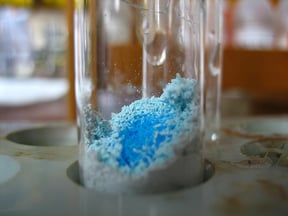 Proteins separated by gel electrophoresis can be visualized using different staining procedures, including Coomassie stains, silver stains and fluorescent stains. Among these staining techniques, silver staining undoubtedly offers the highest sensitivity. However, it also involves a complex and relatively time-consuming protocol, has a low linear dynamic range and reproducibility, and is not compatible with mass spectrometry.
Proteins separated by gel electrophoresis can be visualized using different staining procedures, including Coomassie stains, silver stains and fluorescent stains. Among these staining techniques, silver staining undoubtedly offers the highest sensitivity. However, it also involves a complex and relatively time-consuming protocol, has a low linear dynamic range and reproducibility, and is not compatible with mass spectrometry.
How to Choose between G250 or R250 Coomassie Dyes
Topics: Protein Electrophoresis, Protein Detection
Which Stain is Most Compatible with Mass Spectrometry?
 Once proteins have been separated and resolved by SDS-PAGE or 2D electrophoresis, the proteins are visualized using different staining procedures. For this purpose, most laboratories worldwide use three common protein staining techniques: Coomassie brilliant blue, silver staining or fluorescent staining. So, how do you know which stain will be best suit for mass spectrometry? Here are some things you need to consider to help you come up with the right decision.
Once proteins have been separated and resolved by SDS-PAGE or 2D electrophoresis, the proteins are visualized using different staining procedures. For this purpose, most laboratories worldwide use three common protein staining techniques: Coomassie brilliant blue, silver staining or fluorescent staining. So, how do you know which stain will be best suit for mass spectrometry? Here are some things you need to consider to help you come up with the right decision.
Topics: Protein Detection
Chromogenic Protein Detection: Is It a Suitable Alternative to Chemiluminescence?
When doing a Western blot procedure, the macromolecules are first separated using gel electrophoresis. The separated macromolecules are transferred onto a second matrix (nitrocellulose or polyvinylidene difluoride (PVDF) membrane) and the membrane is blocked to prevent the nonspecific binding of antibodies to its surface. The transferred protein is then complexed with an enzyme-labeled antibody (probe) and an appropriate substrate is added to produce a detectable product.
Topics: Western Blotting, Protein Detection




